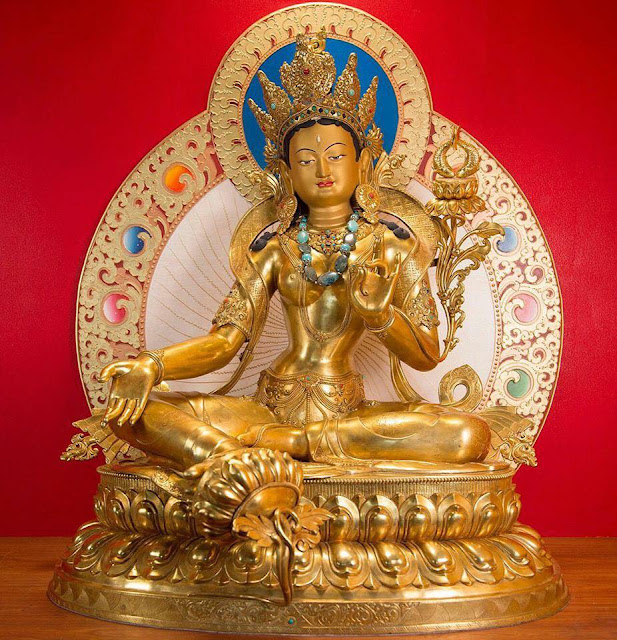The White Tara (Sanskrit: Sitatara; Tibetan: Sgrol-dkar). She symbolizes purity and is often represented standing at the right hand of her consort, Avalokiteshvara, or seated with legs crossed, holding a full-blown lotus. She is generally shown with a third eye.
Tibetans pray to White Tara especially for health, healing and longevity. She offers healing of our wounds, whether it is our bodies or our minds that have been hurt.
White Tara, known as Sita Tara in Sanskrit, is worshipped as the mother of all Buddhas and an embodiment of the maternal aspect of compassion. Her white color is a symbol of purity, the immaculate truth of the Dharma and perfectly pure wisdom.
She is also associated with long life, the healing of physical and mental illnesses, and the elimination of difficulties that appear on the road to the ultimate goal of enlightenment. Her power is related to the prevention of accidents, natural disasters, lack of physical vitality, and anything that could endanger life.
The white form of Tara is very popular in Tibet, where she is known as Drolma Karmo or Drolkar. In the pantheon of Tibetan Buddhism, she serves as the main deity of longevity together with Amitayus and Ushnishavijaya. Tibetans worship Tara as one of the most important deities along with Avalokiteshvara, the Bodhisattva of compassion. They recognize her enlightened nature reincarnated in women with extraordinary qualities.
You might have obstacles in your life that could cause your untimely death. If the obstacles are due to your good karma and merit being exhausted, then in order to prolong your life now and to have longevity in future lives, you need to practice powerful ways to collect a lot of merit, such as taking long life initiations, reciting the mantras of long life deities, saving the lives of animals and people, offering medicine to people and taking care of sick people, offering food, clothing and shelter to the poor people.
If the obstacles in your life and untimely death are due to negative karma, the solution is to purify it. You can also make butter lamp (light) offerings to the Triple Gem. Butter lamp offerings help you develop Dharma wisdom and clairvoyance due to their nature of dispelling the darkness around holy objects. White Tara is extremely powerful.
Green Tara and White Tara both are very close to sentient beings, like a mother to her children. She is very quick to fulfill our wishes and to grant us happiness and a long life, as well as to help us develop wisdom. By taking refuge in Tara and practicing meditation, visualizations, and having faith, you have the power to remove obstacles to your life and to prolong your life.
Tara is closely related to Chenrezig (Avalokitesvara), the Bodhisattva of Compassion. One story of her origin says that she was born from Chenrezig’s compassionate tears. People also think of her as the female manifestation of Chenrezig, or his consort.
Though all the manifestations of Tara share the characteristic of compassion through this connection to Chenrezig, it is White Tara, who is most closely linked to his essential compassionate nature.
Her pure compassion for our suffering, which is thought to be greater even than a mother’s love for her child, is symbolized in images of White Tara by her white color. Her whiteness also indicate the “undifferentiated truth of the Dharma.
In comparison to Green Tara, who is shown seated with one leg on the ground, ready to come to our defense, White Tara is seated in the more meditative diamond lotus position, with both legs folded under her, and her feet facing skyward. White Tara has 7 eyes — with an eye in her forehead, and one on each hand and foot — symbolizing her compassionate vigilance to see all the suffering of the world.
Her left hand is in the protective mudras and her right in the wish-granting mudra. In her left hand, she usually holds a stem of the Utpala lotus flower with three blossoms. One blossom is represented as a seed, a second as ready to bloom, and the third in full bloom. These represent the Buddhas of the past, future and the present. Often, a small image of Amitabha, a Buddha is known for longevity, is portrayed as seated in White Tara’s headdress or slightly above her head.
White Tara Mantra
The White Tara mantra has a number of variations, but a common one in its Sanskrit form is:
Om Tare tuttare Ture Mama Ayuh-Punya-Jnana-Pustim Kuru Svaha.
White Tara Mantra meaning on syllables
As a variant form of Green Tara, her mantra begins very similarly. But added to the play on the name of Tara are several words connected with long life and wellbeing.
Om it can also be reflective of an awareness of the surrounding universe. It is used at the start of many mantras.
Tare this is representative of salvation from suffering and other forms of mundane dangers. Tara is very often depicted as being one who can alleviate suffering from accidents, crime, and natural disasters.
Tuttare is representative of the delivered down the right spiritual path and the need for protection from dangers to the spirit. Delusion, hatred, and greed are the three primary spiritual dangers that are responsible for suffering in us all.
Ture this is representative of the deliverance of the true spiritual path of a Bodhisattva. With this syllable, Tara is said to liberate us from the suffering we are inflicted with while helping us to progress along the path that will allow us to have compassion for others.
Mama means “mine” and indicates that you’d like to possess these qualities of long life, merit, wisdom, happiness, etc. You can of course choose to wish these qualities for someone else — perhaps for a teacher or for a loved one who is ill.
Ayuh is long life (as in Ayurvedic medicine).
Punya means the merit that comes from living life ethically, and this merit is said to help one to live long and happily.
Jnana is wisdom.
Puntim means wealth, abundance, or increase.
Kuru is a mythical land to the north of the Himalayas, which was said to be a land of long life and happiness (it may have been the original northern home of the Aryans). Perhaps the association with the mythical realm of Kuru doesn’t hurt when doing the mantra. But here the word kuru is a verb form meaning “do it!” or “make it so!” With this “make it so!” we’re imploring White Tara for an increase in wisdom, merit, and long life so that we can gain enlightenment and help all sentient beings.
Svaha is said to be representative of “allow the meaning of this mantra to take root in my mind.”It is also an exclamation meaning “hail” or “may blessings be upon” and is a common ending to Buddhist mantras. So after making the rather bold request of White Tara above, we end with an equally emphatic salutation.
Click below to play our YouTube video of the White Tara Mantra:
White Tara is popular because it is known for giving a blessing for long life. For this reason, many practitioners receive an initiation into the White Tara and perform the appropriate practice when they become sick. She will come to their aid and save them from illness and death.
Green Tara and White Tara both are the flawless expression of the inseparability of emptiness, awareness, and compassion. Just as you use a mirror to see your face, Tara meditation is a means of seeing the true face of your mind, devoid of any trace of delusion.”
White Tara is extremely powerful. Tara is very close to sentient beings, like a mother to her children. She is very quick to fulfill our wishes and to grant us happiness and long life, as well as to help us develop wisdom. By taking refuge in Mother Tara and practicing meditation, visualizations and having faith, you have the power to remove obstacles to your life and to prolong your life.”
Dana (Donations for our Buddhist research and development)
Do you earnestly cherish our devoted work? Assuming this is the case, we are delighted that you are finding our blog useful and valuable. Would you consider making a donation for our Buddhist research and development?
We need your help to secure the future of scholarly interaction with Buddhism. Since our very first publication of Dharma works and activities in the year 2008, we had been effortlessly providing free distribution of Dharma posts and articles throughout the previous 13 years. We have exceptionally constrained supports and do not receive subsidized or funding from people in general.
Please help us and to develop our Dharma activities that will not only benefit you, but to all Dharma readers on the planet. Please consider showing your support. Your generosity will certainly help us to enhance our work and to accomplish for a better and brighter prospect to come.
Thank you for reading, may you find peace and great bliss. With your support it helps to spread the Buddha’s precious teachings and turning the Dharma wheels in the world.
Aspiration For Bodhichitta
For those in whom the precious Bodhichitta has not arisen
May it arise and not decrease
But increase further and further.
Dedication of Merit
By this merit may we obtain omniscience then.
Having defeated the enemies wrong-doings.
May we liberate migratory from the ocean of existence.
With its stormy waves of birth, old age, sickness and death.
*Note
I do not own or infringe any copyright of the picture(s).
Picture(s) courtesy and credit to the rightful distributors and or studios.
Picture(s) is/are intended for editorial use only.






































